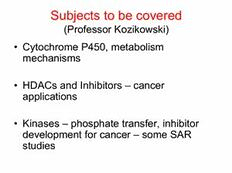
Drug Metabolism Cytochrome P450 PDF
Preview Drug Metabolism Cytochrome P450
Subjects to be covered (Professor Kozikowski) • Cytochrome P450, metabolism mechanisms • HDACs and Inhibitors – cancer applications • Kinases – phosphate transfer, inhibitor development for cancer – some SAR studies Metabolism • Sum of processes by which particular substances are handled by the body. • From the Greek, metabole -- change Drug Metabolism – Cytochrome P450 Substrates can undergo a broad range of reactions during metabolism. These reactions include, for example, oxidation, reduction, hydrolysis, hydration, conjugation and condensation. Drug metabolism is divided into 2 Phases -- Phase I which are the functionalization reactions; And Phase II, which are the conjugation reactions. Drug Metabolism • Foreign organism – elicits antibody response • Low molecular weight xenobiotics – nonspecific enzymes convert them into polar molecules for excretion • Enzymatic biotransformations of drugs – drug metabolism Principal site of drug metabolism is the liver; also kidneys, lungs, GI tract Pathway of Oral Drugs take via absorbed through small mouth intestine or stomach bloodstream liver (first metabolized) Drug metabolism by liver enzymes – first-pass effect Example of Phase I and II Phase I Phase II OH O-SO H 3 Drug Metabolism • Drug metabolism is desirable once drug has reached site of action – may produce its effect longer than desired or become toxic. • Drug metabolism studies are essential for the safety of drugs. Metabolites must be isolated and shown to be nontoxic. Metabolism Studies Can Be a Useful Lead Modification Approach Approach: The antihistamine terfenadine (7.4, R = CH ) was 3 removed from the drug market because of arrhythmias. Its metabolite fexofenadine (7.4, R = COOH) is as active, but does not produce arrhythmias. H C 3 R HCl CH 3 HO N OH terfenadine HCl (R = CH ) 3 fexofenadine HCl (R = COOH) 7.4 Pathways for Drug Deactivation and Elimination Rate and pathway of drug metabolism are affected by species, strain, sex, age, hormones, pregnancy, and liver diseases. Drug metabolism is stereoselective, if not stereospecific. Generally, enantiomers act as two different xenobiotics – different metabolites and pharmacokinetics. Sometimes the inactive enantiomer produces toxic metabolites or may inhibit metabolism of active isomer. Metabolism of enantiomers may depend on the route of administration. For example, the antiarrhythmia drug verapamil is 16 times more potent when administered i.v. than orally.
